by Dave Arnold
Strap yourself in and get ready to keep track of many tastings. For some French Fry background, see the previous post FF Supremacy Part 1. We use a blanch-dry-fry-fry technique; this post investigates the ins and outs of pre-blanching, blanching, and drying.
Spoiler alert: here’s the final answer … Soak the cut fries for one hour in a room temperature solution of Pectinex SP-L (a pectolytic and hemicellulolytic enzyme mix), blanch in boiling water (don’t overload your blanching container) for 14 minutes 30 seconds (assuming your water takes 1:30 to get back to boil), do not dry before frying.
A couple notes: one of the developers of the Cook’s Illustrated recipe, which we discussed in our previous post, sent us an email reply. We are publishing his response, with permission, at the end of this piece. Our next French Fry post will deal with potato types, oil types, and freezing between first and second fry. Don’t look for it right away. My interns are really, really sick of making fries.
What Is the Ideal Fry?
The sixty-plus, side-by-side blind tests we conducted in the past week and a half have changed my ideal fry. Prior to this marathon I posited that the crunchiest fry would be the best fry. Not true. We aim for crunchiness because we think it’s the opposite of sogginess, that most dreaded of French fry attributes. The truth is, a fry just needs to be somewhat crunchy, with no signs of sogginess.  Too much crunch becomes hardness –a turn-off. We produced some specimens that were basically potato chips shaped like fries, and they weren’t good. What is good? A fry you want to keep eating even after it has gone cold.
Our ideal fry:
- tastes delicious right out of the fryer with a crunchy crust and hearty, cooked potato interior texture
- is salty on the interior and exterior
- avoids “hollow fry†(see the previous post for more explanation)
- is still desirable after it gets cold
- doesn’t get soggy while cooling, and doesn’t taste dry after cooling
- isn’t greasy. Note that greasiness does not necessarily correlate to the oil content of the fry.
4 and 5 are especially important. A monkey can make a French fry that tastes good right out of the oil –but he needs your help to make one that stays good as it cools down.
Blanching Theory:
Blanching fries does a lot for you – such as:
- killing the enzymes that make the potatoes turn purpley-brown. Blanching is always necessary if the potatoes will be air-dried before frying.
- gelatinizing the starch. During frying, pre-cooked fries form a crust faster than raw ones, and they can be cooked at higher oil temperatures than raw fries – which is easier for workflow.
- pre-salting the interior of the fries. We blanched two batches of fries, one in boiling 3% salt water, one in boiling plain water. The plain-water fries tasted like crap next to the salt-water ones. All subsequent tests fries were blanched in a 3% salt solution. So here’s your First Rule: Use salt water to blanch.  And remember, the potatoes absorb salt. If you re-use your blanching water, add more salt. Potatoes properly blanched in a 3% salt solution need very little additional surface salt.
- getting rid of the excess sugar  that leads to overly dark fries.  If you re-use your blanch water, the sugars will equilibrate and you’ll lose this advantage.
- altering the texture of the finished fry. This effect is the hardest to sort out. How does blanching change the texture? Keep with me:
Many people advocate blanching fries until they “almost fall apart.†To test this advice we blanched fries in boiling water with 3% salt for different lengths of time. We boiled a large amount of water and added all the potatoes at once. The water never went below 85°C and it returned to a boil in 1 minute 30 seconds. We pulled some fries at 5 minutes 20 seconds, when the potatoes were done. We overcooked the rest, pulling some at 7 minutes 11 seconds, 9 minutes 11 seconds, 11 minutes 11 seconds, 14 minutes 30 seconds and 20 minutes zero seconds.
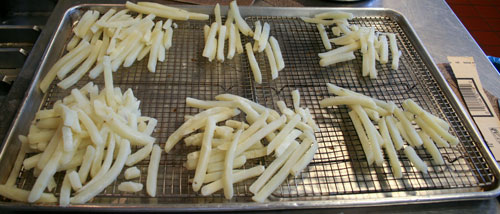
We dried all the fries in a convection oven with door open and the fan set to cool; fried them in 170°C oil until they formed a crust but were still blond; then fried in 190°C oil until crispy and golden brown. The internal texture of the fries remained fairly consistent, but the crusts became progressively crunchier as the cooking time increased. The 14:30 fries were unanimously voted first place. The 20 minute fries didn’t brown well and were overly salty; nobody liked them. A strange phenomenon occurred with the 11:11 fries –they were saltier than the 9:11 fries and the 14:30 fries. Weird, because they were all cooked in the same pot. I think I know why:  aside from being too salty, the 11:11 fries also seemed a bit hollow. I think they dried out a little more in the convection, which would lower their moisture content, making them seem saltier –and, as we shall see – leading to a hollow fry. Second Rule: Blanch fries for a long time –like 14 minutes and 30 seconds, in boiling water.
Some like it Rough:
Many people assume that long blanching times make a better crust because overcooked potatoes have a rough surface that gets crunchier than the smoother surface of a less-done potato. To test this hypothesis, we made 3 batches of fries:
- Blanched until done –the control.
- Blanched until done, and scraped with coarse sandpaper to make a rough surface.
- Cut oversized, blanched to death, cooled and cut down to size by hand with a sharp knife to create a smooth surface.
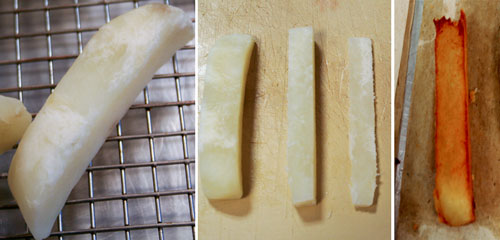
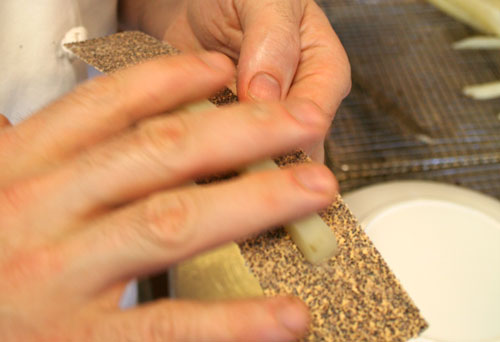
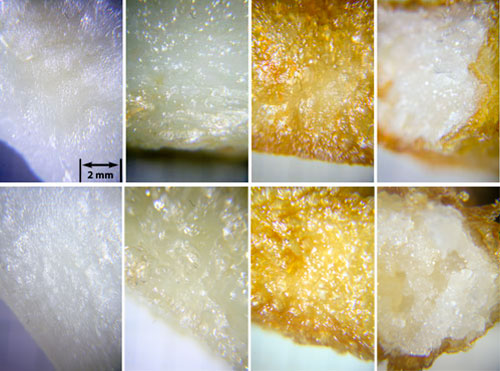
The sandpaper batch was a little crunchier than the control, but not nearly as crunchy as the overcooked batch that we cut smooth. I don’t think this test is conclusive, but I do think that surface roughness is a minor, not major, player in crunchiness. If you look at the pictures of the fries blanched at various times, only parts of the surface of the overcooked fries appear any more beat-up than the normal ones, yet the whole fry is crunchier.
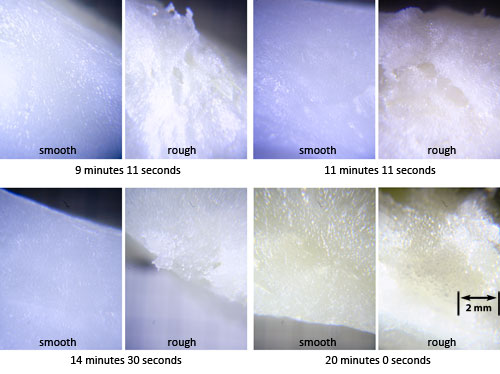
Porosity and surface fissures may play a big role, but I don’t think macroscopic roughness does.
Starting With Cold Water, and Pre-Blanch Tricks: Pectin vs Starch:
Potatoes are made up of cells filled with starch granules glued together by pectin, hemicellulose, cellulose, and other junk referred to in the biz as Non-Starch Polysaccharides (NSP).  Blanching at temperatures above 75°C cause starch granules to swell. The longer and hotter the blanch, the more the granules swell, until they finally break. Destruction of starch granules doesn’t necessarily mean destruction of potato cells. –research indicates that the cells stay mostly intact during long cooking, even though starch leaks out of them. Long blanching at high temperatures also breaks down pectin, making French fries softer. Blanching or pre-blanching at temperatures below 75°C –or blanching slowly so the fries stay between 60 and 75 degrees C for several minutes — activates an enzyme called pectin methylesterase (PME). In the presence of calcium, PME strengthens pectin and allows it to withstand the rigors of cooking without breaking down,  producing a fry that is stiffer and has more structure than the same fry without the low-temperature blanch. Even though PME is active at temperatures below 60-70°C, the calcium the enzyme needs to work remains locked in the starch granules at lower temperatures.  Above 75°C, PME is denatured too rapidly to make a difference.   The two basic techniques for PME activation are:
- Pre-blanch the fries in a temperature-controlled water bath between 60 and 70 degrees C for several minutes, up to an hour. We call this “the Steingarten†in honor of Jeffrey Steingarten, who uses this technique on mashed potatoes. We did this procedure for one hour, then blanched in boiling water till overcooked.
- Start the blanch with cold water, or allow the temperature of the blanch water to dip below 70°C when you add the potatoes to the water. Even a couple of minutes below 70-75°C is enough to get some PME effect. For our test, we started from cold and blanched for 25 minutes (it took about 15 minutes to boil).
I have a bottle of straight PME enzyme called NovoShape. It is made by the same folks who bring you Pectinex SP-L and Pectinex Smash XXL, and it is intended to firm up fruits. If you add a pinch of calcium and some NovoShape to raspberries ,  you can boil those raspberries and they won’t fall apart. Your blueberries won’t bleed into muffins. You get it. To really test out PME activation, I decided to use NovoShape on two additional batches:
- Soak fries in a 0.4% PME/0.5 % calcium gluconate solution kept at 25°C (I kept the temperature low so I wouldn’t activate the native PME) for two hours, then blanch in boiling water till overcooked. This treatment should harden the surface only.
- Vacuum- infuse fries with a 0.4% PME/0.5 % calcium gluconate solution and then keep at 55°C (higher temps aren’t necessary because I am adding the calcium) for an hour, then blanch in boiling water until overcooked. This treatment should harden the whole fry.
Compared to the control (blanched in boiling water till overcooked), the Steingarten fry was hard, and the inside hollow. It stayed hard as it cooled, but we didn’t find it pleasant. Perhaps in another circumstance (other than tasting a zillion fries side by side) we might have interpreted this fry as crunchy in a good way. But the multiple tests have shown us a difference between hard (bad) and crunchy (good). Likewise, the fries that had the PME injected into them were hard and hollow –no good. The fries that had been soaked in the PME were hard on the outside, a bit hollow, and also greasy. The ones blanched from cold were crunchier than the control, and looked really good; but didn’t have as much potato flavor as the control. The control was the best of the lot –even though it wasn’t the crunchiest.
Third Rule: Make sure your blanching water is boiling, and don’t let the water temperature get below 80°C. The best internal texture and flavor for French fries is possible only when PME is not activated. We figure the best way to do this in a restaurant situation is to use a pasta cooker for blanching.
While researching enzymes and French fries in the scientific literature, I came across an article on Pectinex SP-L in fries (The Effects of Enzymes on Fat Content and Texture of French Fries, G. Lisinska, et al. Food Chemistry, vol 102 (2007) 1055-1060). Pectinex SP-L is the exact opposite of Novoshape –it breaks pectin down. The theory of the article is that pectin and starch are antagonistic –the starch wants to swell, and the pectin wants to hold it back. As the potato is fried, the starch swells and eventually dehydrates, forming a crust on the fry. If the pectin at the surface is not degraded, fissures appear in the crust as it dries, leading to more oil penetration (the main focus of the article is preventing oil penetration, because people are obsessed with fat content – and because oil is more expensive than potatoes). Using SP-L breaks down the pectin at the surface, allowing major starch expansion and preventing fissures and cracks in the crust. Here are the SEM pictures from the article borrowed without permission:
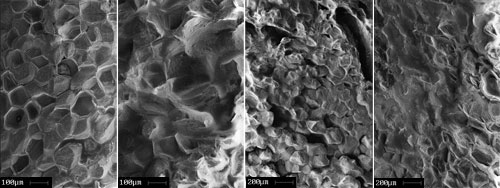
OK –more tests.
- French fries soaked in a 0.4% SPL solution at 25°C for 1 hour and then blanched for 14:30 in boiling water. This should soften the surface.
- French fries vacuum injected with a 0.4% SPL solution at 25°C for 1 hour and then blanched for 14:30 in boiling water. This should soften the whole fry.
- French Fries vacuum infused with a 0.4% PME/0.5 % calcium gluconate solution and then soaked in a 0.4% SPL solution kept at 55°C for an hour and then blanched for 14:30 in boiling water. This should soften the outside of the fry but harden the inside. We did this one just for giggles, even though we were skeptical about using PME. We were rooting against this technique, because it is a pain in the rear.
The SP-L injected fries were a complete disaster. They wouldn’t brown properly and were hard like rocks. The PME-injected SPL -soaked fries were good, but they didn’t have as much potato flavor as the control, and they seemed hard. As they cooled they got dry. The SP-L soaked fries were a huge winner. They had a great potato flavor and a great crust. The crust lasted much longer than the crust in the control, but wasn’t hard or dry. This was a fry you could eat cold.
PS: You can get Pectinex SP-L from us if you can’t get a sample from Novozymes or Gusmer.
Fourth Rule: Soak your fries in a 0.4% solution of Pectinex SP-L at 25°C for about an hour before you blanch.
To Dry or Not To Dry:
Our standard practice has been to dry out our fries after the blanch, but before the first fry. We scoop the fries out of the blanching water, carefully put them on cooling racks, and put them in a convection oven with the cooling fan on and the door ajar. Sometimes, if the fries don’t get dried off right away, I’ll put the convection on low (60 or 70°C) to dry them out faster. At home I use a three-speed fan or a hair dryer. The reasoning behind drying: after frying, the potatoes will stay crunchier, longer, because they have less internal moisture. The fries form a better crust because their surface is dry before they go into the fryer. The literature (see bibliography at the end of the previous post) says that dried French fries absorb less oil than fries that haven’t been dried (although there is some confusion about how oil content is measured –see the article Understanding Oil Absorption During Deep Fat Frying, by Pedro Bouchon, which is chapter 5 in Advances in Food and Nutrition Research, vol 57 2009). The amount of oil a fry absorbs is roughly proportional to the amount of water that is boiled out, because the oil gets injected into the voids left by the water as the fry cools. Dried fries are compacted more and have a denser surface, so they absorb less oil. But…. do they taste better?
In the informal side-by-side tests I have run over the years, dried fries have always won. But now that I was more focused on internal texture, I wasn’t sure how the tests would pan out. We blanched a bunch of fries using several techniques: SP-L soak, PME soak, boiling blanch, blanch from cold, etc. We dried half of each batch in the convection oven with the door ajar, and fried the other half without drying.
In general, dried fries were crunchier than non-dried fries, but they tended to be hollower, and they tended to taste hard and dry when cold. The fries that had had not been dried, although not as crunchy as their dried brethren, always had a better internal texture and potato flavor, and remained pleasant even when cold –sometimes they even seemed to get better. For instance, in blanched-from-cold French fries (with some PME activation), tasters preferred the dried fries straight out of the fryer, but after 10 minutes, the un-dried fries were surprisingly pleasant. Not super crunchy –but not soggy.
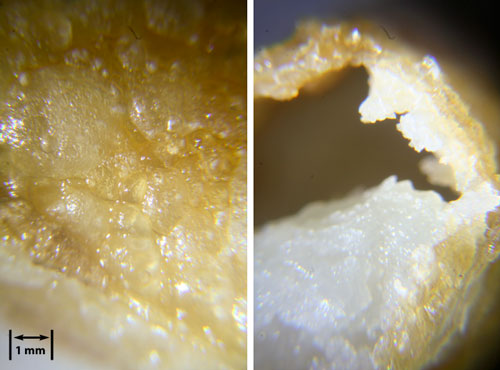
Our favorite blanching technique, SP-L soaking, and the runner-up, straight boiling, responded slightly differently to drying. The standard boil wasn’t quite crunchy enough when fried without drying. The dried, standard-boil guys were crunchy –but a bit hollow. I think we had over-dried them. In the case of regular boiling, I think a happy medium between no-dry and really-dry would be best. On the other hand, the SP-L soaked fries were crunchy enough straight out of the fryer, had a great potato flavor, and tasted not good, but great, when cold. The cold fries were not soggy, not dry, and not hard. Not super-crunchy, but crisp and pleasant. I could eat them all day.
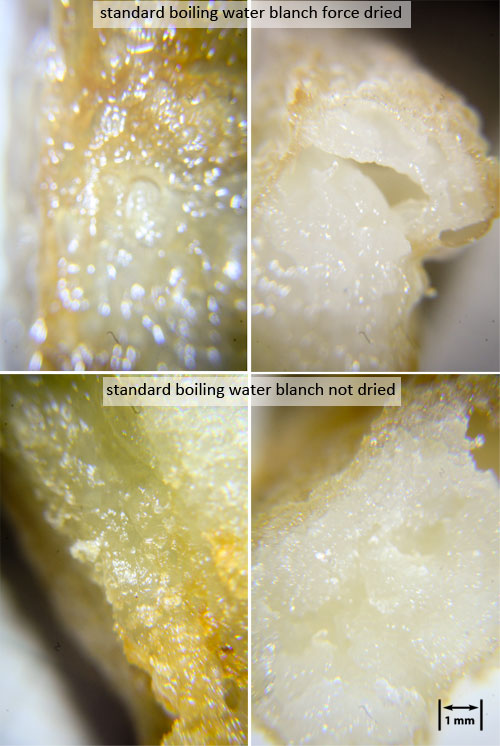
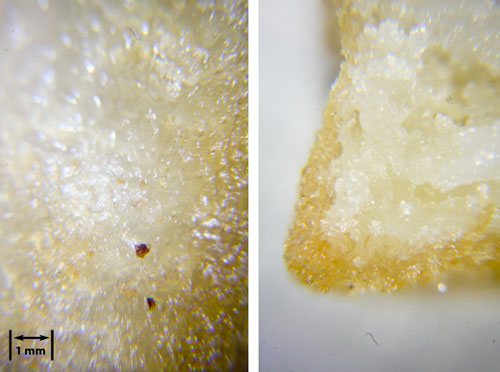
Fifth Rule: Don’t dry your fries too much –they will turn hard and hollow. Some fries, like the SP-l soaked, shouldn’t be force dried at all.
The current technique in a nutshell: Peel potatoes, cut into fries and rinse. Soak in a 0.4% solution of Pectinex SP-L and water for 1 hour at room temperature. Blanch fries in boiling water with 3% salt added (or to taste). Make sure the water temperature doesn’t drop below 80°C. Blanch for 14.5 minutes. Drain fries on a cooling rack, but don’t force dry them. Fry them at 170°C till they form a crust but are still blond. Fry a second time in 190°C oil till crispy and golden brown. Eat.

Addenda:
We took our magnified pictures with this rig:
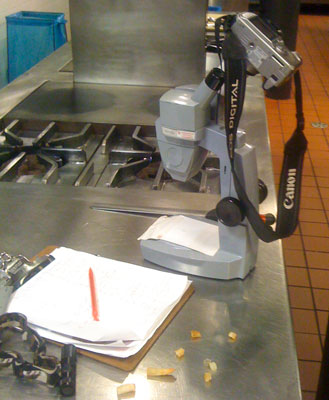
Vinegar Fries
We make a lot of vinegar fries.  We inject vinegar into raw fries and then blanch those fries in vinegar. It takes a long time to cook potatoes in vinegar. The acid makes it more difficult to break down the pectin. We tested our vinegar blanching technique against our new favorite blanching technique. They tasted like vinegar –which is good, but they were hard –which is bad. We had always liked them –because they are super-crunchy, but now we were a little disappointed by the texture.
Weird Enzyme Thingy
One of our tests (not reviewed) involved blanching fries starting with cold water and pulling them out when they reached 70°C. Those fries turned a weird purple –just like they hadn’t been blanched at all. The ones that were pulled at 60°C didn’t change color –neither did the ones pulled at 80°C. Any ideas?
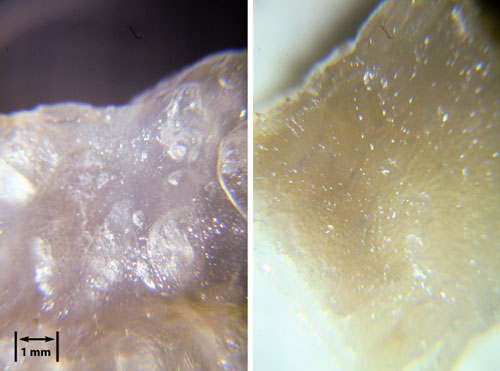
A Response from a Former Cooks Illustrated Tester on Frying in Cold Oil:
“We didn’t have the same problem that you guys did with the fries – they were slightly greasier than normal but by no means unacceptably so, and they stayed crisp for longer as well. Granted, our focus with the recipe was more on hassle and less on quality – we would never be able to publish a three-stage fry. From looking at the pictures accompanying the post, I think that the burner you were using was considerably more powerful than the ones we tested on – we don’t use restaurant-grade stoves here, really. With a lower oil temperature, the fry spends more time cooking through, and presumably loses more moisture as well. We had an ancillary problem that we think had to do with the relative age of the potatoes – some fries would come out incredibly crispy, but others would just be tough. We think that this tendency had to do with the relative sugar content of  the potatoes, as we had no way to control for the age of the potatoes and so some were doubtlessly stored longer than others, and we had no idea which were which. I’d be interested to see if we can find a way to control for that.â€

Hmm… where do I find these monkeys that make French fries?
This may be a dumb question (I checked back through the post, and couldn’t find a clear answer), but did you try a control group of fries soaked in plain water for an hour to compare if soaking had any affect on its own? I feel like this would be an important comparison to the fries soaked in .4% Pectinex SP-L for an hour.
(Again, sorry if this was already tested, just didn’t see it there myself)
Sam,
Before I answer your question, I think the SP-L soak time should probably be increased to 2 hours. One of the winning batches soaked a little longer but we haven’t had the time to run a test for SP-L soaking for 1 vs 2 vs 3 vs 4 hours, or SP-L soaking at 40C (which still shouldn’t activate too much PME) for a shorter time.
Your question: We did not run an SP-L vs Water soak test. We have run PME/Steingarten/Water-Soak/No-Soak tests. Given our blanching times, the soak didn’t make a difference in those tests. Also, In the testing for this post we bulk cut our fries into cold water and then divided them into batches. They all, therefore, had some soak time in water before testing (it takes a while to set up all the tests). From test to test all the fries would have a similar soak time, but we didn’t control for it.
Dave,
First let me compliment you on your photomicroscopy and… presenting the SEM work is very instructive… over the top! [I am a metallurgical geek, this kind of stuff really lights my fire.]
Forgive me if this is off topic. The most outstanding and shockingly easy fries I have make lately were sweet potatoes, washed, unpeeled. Thinly sliced on one of those Kyocera mandolins, dropped into 375F corn oil and salted while hot.
Another unexpected aspect is, there were a few left around the next morning and in the interest of science I tried one and it was still very nice.
Hi Phoxx,
I haven’t done too much research on sweet-potato fries. How thinly sliced?
I do the triple fry pretty much once a month since you mentioned it here last christmas or when it was.
I noted that overcooking indeep produces a better fry but haven’t been able to manage that since e standard 3/8 inch fry will fall apart upon touch when overcooked.
Does the 14.30 refer to a standard fry or do you cut thicker? Or does the sp-l help so much that they don’t fall apart?
For those who don’t want to jump through hoops for fries, at least try the water boiling in heavily salted water. That does wonders for the fry taste.
Howdy JK,
The 14:30 was our standard 3/8 inch, but we didn’t dump them out on the rack like we normally do, we scooped them out gently with a spider. Also, we adjusted the boil down so they didn’t get too knocked about in the pot. The 14:30 was better than the 11:11, which was better than the 9:11, but they were all pretty good.
hey Dave – just tried the 2 hour SP-L soak/14:30 simmer/fry/fry…. fries came out fantastic – probably the best I’ve ever had – but I did have quite a few casualties that basically disintegrated when I gently put my spider into the simmering water to remove them… is there a trick, or should I build a draining rack that can be put in the pot prior to adding the fries so I can just lift the whole pile out of the water without disturbing them?
Howdy Kenneth T,
I’m glad your fries were good. Breakage is a problem. I am just super careful (but they still break). I ladle them onto quarter size drying racks and then slide the whole batch from the rack into the oil. If you need to minimize breakage you can lower the blanch time a little –try 11 min. I don’t think they’ll be quite as good, but they’ll be more intact.
Hi – I couldn’t wait to try your FF method, so I made fries your way yesterday, except for omitting the Pectinex Ultra SP-L, which I don’t have.
These were the best fries I have made in years. Really crispy, with a nice interior, and they stayed crisp and tasty as they cooled. Its a bit more work, but why not have them the way you want them? Thanks for all your research, and the results justify it.
Thank you for the kind words IanG
me and my friends often argue about whether we like the McDonalds thin cut fries or the KFC/fish and chips thick cut. Personally like the thin cut.
I suppose a next question would be potato age, different varieties of potatoes and types of oil. Hmm… Degustation of chippies.
This is another incredible article! I love your scientific analyzations of food. I’ve been waiting for the follow up fry supremecy part 1. Now I can test it out to see if it is as you tested. Thanks!
Diana
Brilliant stuff, but what would be the “spoiler alert” for those of us that can’t secure Pectinex SP-L?
Also, I found it very interesting the overcooking led to a crispier fry…..Any intention to make the perfect onion rings after this? (joke :p)
Howdy Lou,
The problem with SP-l is that Novozymes only sells it in 25 liter pails. We bought a pail and we resell it to chefs through paypal. Go to http://www.paypal.com and use the email address: nlopez@frenchculinary.com. We sell 250 mL bags for $20 plus $5 shipping.
hello, Mr.Dave and Mr.Nil. Recently I have had an opportunity to make potato chips in the restaurant that I work for. One of the chefs was from Maine and he loves Red Sox. Every time he mentions anything that are related to those 2 things, he goes extremely favorable to whatevery he is talking about. So I did not believe him 100% when he mentioned this potato from Maine called Kennebeck. After my first try, I was astonished and convinced that he was right. I have just asked him if the kennebeck would be superior if french-fried to Idaho. His answer was “it’s the best.” I knew that was going to be what he was going to say. But now I believe it. If kennebeck potato has not been tested, I strongly believe, you need to test it. This potato is, without a doubt, superior to Idaho, especially, in its crispiness once it’s been fried.
Hello Koji,
We will try to get Kennebecs when we do our tater testing.
I have tested Kennebecs extensively (though not with your rigor) after hearing lots about how great they are. The upshot is this: chefs like them because it’s really easy to get a slightly-crispy exterior when you only fry them once. It allows them to be lazy. Even though the Kennebec fry’s exterior is adequately crispy (and stays crispy), the interior sucks. It’s hard, starchy, not very flavorful, and generally unpleasant. Frying them twice doesn’t improve the exterior much, and it makes the interior even worse.
Kennebecs are a curiosity, and they’re worth your testing. Maybe there is a way to improve them by the right combination of blanching/soaking/frying. As for me, I’ve sworn them off as inevitably producing a not-that-delicious fry, and have since tried them at several restaurants that touted the potato variety and felt the same way.
Great info Barzelay,
I spoke with Tod Schmidt, northeastern foodservice field representative for the Idaho Potato Commission, about Kennebecs. Here is what he said: Yeah, Kennebecs are great… if you can get them right out of the field. They have a short storage life… like zero.
As if on cue, Alex posted about In N Out’s great burgers and shitty fries: http://blog.ideasinfood.com/ideas_in_food/2010/05/first-time.html. They use Kennebecs.
All he’s saying is that they spoil quickly. That doesn’t mean they make good french fries when fresh. When I’ve used them, I have been getting them directly from the farmer and frying them the day after they were picked.
I grew Kennebecs last summer, and — although I didn’t fry any of them — they were indeed delicious right out of the ground. My problem was that my potato plants all got blight and died, so I had to cook and eat what I did get ASAP. Heartbreaking, especially if you’re in the least bit Irish.
Better luck this year John!
Awesome detailed analyzation of the humble fry. Now if you could just figure out the secret recipe for the Krabby Patty…
Is there anyway to add the proper enzymes to the water soak without the Novozyme product… like adding another vegetable, fruit, hunk of raw meat, etc. to the product. What would be a natural source of this enzyme?
Howdy Chadzilla,
That is an excellent question. I haven’t thought about it. Unlike Pectin Methylesterase, which is present in most vegetables to a degree, the pectinases, etc in SP-L are all about breaking plants down. I don’t know if there is some fungus out there that you could culture and have the same effect.
In this same line of thought, how about soaking the blackberries in a 65C puree (or juice) of raw potatoes? Would the PME do its thing on the blackberries and allow their cooking without breaking down?
We use 50C with Novoshape PME on raspberries. Works great. Dunno if endogenous enzymes will work.
I was just thinking, do you think a calcium hydroxide soak would have a similar affect? i know they make sweet potato fries crispy, so maybe it’s worth trying next to the sp-l?
Howdy Lou,
There is a line of comments on this in the first fry post. Tavarino tried it out and said it didn’t work.
Hello, I just found your posts yesterday and am extremely excited to try it out! I’ve been trying to make crispy fries with just the double-fry method and am having a hard time!
I’m wondering if you’ve ever read the article on Burger Labs on the double frying method:
http://aht.seriouseats.com/archives/2010/01/the-burger-labs-why-double-fry-french-fries.html
Seems like this guy is able to get a crispy fry by just double frying. Any thoughts?
Howdy Sheryl,
What problems have you been having and what is your procedure? you can make crunchy fries a number of ways, but the best way to control the inside texture and outside texture is by blanching then frying twice.
Hi Dave – how are you doing?
FYI – just wrote a piece about trying to replicate McDonald’s-style fries at home (which, IMO are excellent – when they are at their best):http://aht.seriouseats.com/archives/2010/05/the-burger-lab-how-to-make-perfect-mcdonalds-style-french-fries.html
The conclusion I came to was that if you add just a little vinegar to the initial blanch, the acid helps strengthen the pectin in the fries enough that you can boil the heck out of them without them breaking down on you, which makes the whole process much easier (also, I didn’t have any pectinex or Novoshape).
For a home cook without access to that kind of stuff, it seems to work out really well. Any thoughts?
Ack – just saw you address that in a tiny graf towards the bottom of the story.
Have you tried it with just a little bit of vinegar? I don’t find them to be very hard at all when the ratio is about 1:64 (1 tablespoon in a quart). What ratio were you using?
We do them in straight vinegar. We originally did it for flavor, not texture. The texture was a side issue we noticed. We haven’t tested small amounts of acid; but our current thinking is that pectin destruction at the surface, rather than pectin enhancement, is the way to go.
It is interesting what you mentioned in your first post – that both pectin enhancement and pectin destruction improve the fries over their norma state.
I know you’ve talked about being careful with the fries after their blanching step – do you find that the ones that have been treated with pectinex are even more likely to fall apart on you when boiling?
The problem I had before I started adding the vinegar was that about half of the fries would disintegrate when I put them into the fryer, fucking up my oil, and turning into little burnt nuggets that I’d have to pick out of the other fries. You must either have steadier hands, more patience, or firmer potatoes than me (or maybe all three?)
Howdy Kenji,
Yeah, there is a balance to strike. If intact fries are important, cooker shorter (for about 11 min), if intact-ness isn’t super-important, cook for 14-15 min. We are super, super careful when we take the fries out of the water. We put them on quarter-sheet drying racks and load the whole rack-full into the fryer at once to minimize handling. I have potatoes that break, but I don’t have disintegration problems. We have currently been testing a pre-soak in salted spl with subsequent steaming in the combi on racks. This should give us a “no touch” fry. If we let them cool enough before frying (without overly dehydrating them), we should be able to get intact overcooked fries. Are your fries 3/8 inch? Also, on the burnt nuggets messing up the oil, that is where a commercial deep fryer really shines. I am considering doing a general frying post. I don’t think most cooks (who don’t get to use professional equipment) understand how much better a professional fryer is than a home fryer. I think most people assume the difference is only a matter of power and capacity. The key to professional tube-style fryers, as you know, is two-fold — 1. huge amounts of power delivered over a large surface area which minimizes recovery time and local overheating; 2. the establishment of a cold-zone underneath the tubes that allows particles to settle to the bottom without scorching and ruining the oil.
I have been doing 1/4 inch fries, so that could explain why mine are more delicate than yours. I prefer the higher crust ratio with thinner fries.
And I forgot about that cold zone in commercial fryers. It must make a huge difference. The closest I’ve got to a fryer at home is a big wok, which works, but the oil gets messy pretty fast.
I look forward to reading about your no-touch fries. Sounds interesting.
I thought I’d chime in, since my experiments seem relevant here. Dave, I’ve followed some of your experiments to a t(minus enzymes, sp1 on order), and some of Kenji’s such as freezing for fluff and adding vinegar. My results confirm Dave’s most recent claims that home fryers are inferior.
For my 355ºF fry, I heat my oil to max(375ºF). When I drop a small batch of room-temp fries(30-35ish) in the 3/4 of a gallon of oil, the temp. drops to 260ºF and takes a good 2 minutes to get back over 350ºF. The result is a very mushy interior most of the time. I have to overcook to get any kind of real crisp.
When I bring the same thing to my restaurant and cook there, I get great results. The oil capacity is 4-5 gallons(35lbs.) and the temp. barely swings and recovers in a flash.
Conclusion:
If you want serious fries, get a serious fryer.
Thanks to everyone for their good work and contributions.
You may benefit from the information found in this article on the industrial process by which McDonalds french fries are created:
http://tinyurl.com/2976gcx
The cold reality is that McDonalds has forgotten more about french fries than any of us will ever know. They’ve spent millions and their product is the gold standard in this area. To summarize the differences:
McDonalds fries are 1/4″ square, yours are 3/8″. This would make your fries inherently less crust oriented and more inside oriented. Personally I like the 3/8″ 1/4″ is about as small as I’d ever want to go. 3/8″ is a great all purpose size. Plus, who wants to make fries that look like McDonalds fries???
McDonalds also blanches their fries at 170 degrees for about 15 minutes. Addatives to the blanching water include dexatrose, sodium acid pyrophosphate. Salt is also presumably in the water although maybe not. I don’t expect these additives would affect your fries enough to be worth adding. The sugar levels of your relatively small blanching bath probably vary greatly. Would a little dextrose matter? Since you are working fresh, sodium acid pyrophosphate isn’t needed to preserve color although it may help the fries retain water when frying and could also protect potato pectin. The 170 degrees for 15 minutes show that you both purposely overcook your spuds. If “above 75°C, PME is denatured too rapidly to make a difference” then McDonalds is cooking just above that temperature. This might be to save energy but since Micky D’s fries are dried in a huge shaker after blanching then I have a feeling they come out quite a bit stiffer than yours which were blanched hotter for almost as long but are bigger.
Finally McDonalds fries are fried at 365 for 50 seconds which is pretty hot for a first fry. Your first fry is 340 if I remember correctly.
McDonalds also obviously freezes their fries. Which as you stated would make them even more crust oriented.
I also believe that McDonalds uses multiple varieties of potatoes in their fries. This could be due to the fact that they are the largest buyer of potatoes in the universe. On one hand this gives you an advantage as you could make all of your fries out of one kind of potato if you wanted but I doubt it will make a difference as their isn’t a huge variation between individual McDonalds fries, at least not that I’ve noticed.
Your process is pretty impressive considering it was developed with interns and didn’t take millions of dollars and although I haven’t yet tried your SPL fries, if they taste good cold than they hold up better than McDonalds. I think the 170 degree part (for longer than 15 minutes since your fries are bigger) is definitely worth a shot since during your process the fries are reportedly quite fragile. Spare no procedure when looking for the ultimate fry!
Good work and great writing!
Hi Dave, great stuff as always! congrats…quick question, does the water to solids:ratio matter during blanching? I’d assume it does in the saltiness of the fry, but I wonder what the effect(s) on the textural properties is/are… Thoughts?
On a related comment…I have to second Sam’s question/comment from May 12, the inclusion of the right control(s) within an experimental design is key to the final interpretation of your results…Keep up the great work!
Just curious if you were planning to follow up and test varieties of potatoes for french fries as well?
I’d like to. Hard to find the time
Dave A.,
Are you folks still selling the Pectinex SP-L? I e-mailed Nastassia but got no reply.
Yep. We have some left but are getting a new shipment soon.
Thanks, Dave. I guess I’ll just Paypal the money to her account and include my shipping info. Can’t wait!
The one thing I’m a little surprised you guys didn’t try out was higher frying temperatures (like, borderline-dangerous temps). Recently I’ve tried frying in the low 400’s, as close as I can get to peanut oil’s smoke point (I converted to peanut oil some time back since I was trying to replicate the Les Halles/Bourdain cookbook fries). With some oils you could safely get pretty close to 500 degrees. It seems that you would be able to fry more quickly, get a lovely crispiness and minimize oil absorption.
Also, I was a bit surprised that y’all didn’t give a sous vide step a try somewhere in the process. I know a few others have tried it.
We did do some blanching in the bag but we didn’t get any results we really liked. I’m anxious to try the myhrvold/young method that uses an ultrasonic bath.
Great tips you have here, they are all good and true.
Great tips, the first french fries receipe really tested and proven with scientific facts ! I am french and have never found things like this in France. Hervé This does something like you but not as friendly, popular and widely spread like this.
Do you still have Pectinex SP-L? I ‘ve sent a paypal payment to Nastassia but got no reply.
Hello Duc, I’ll Ask Nastassia.
HI, great post as usual!
I was wondering if you tried different combination of oil temperature and time, eg. 1st fry ad 130C and 2nd at 180C, or 1st at 160C and 2nd at 190C…
In your opinion is it better to fry more in the first fry (without browning) and just let the second fry do a little coloring, or is it better keep the first fry as gentle as possible and let the second fry do the majority of work?
Hello Davide,
I haven’t adequately tested different frying regimens. From experience I feel the first fry shouldn’t be too hot, because you need to develop the crust as well as partially dehydrate the potato without browning; but the oil temperature can be significantly higher than it would be in a no-blanch fry because it isn’t necessary to cook the potato in the frying process. The second fry is not only a coloring step but a dehydrating and crisping step, so I’m pretty sure you can’t skimp on it too much.
Been endeavoring to produce an excellent fry for years.
The quest has proved to be impossible. I’ve produced good fries, but never excellent fries.
The 1960’s era McDonald’s fries when McDonald’s produced the fries in-house are the standard by which excellent fries should be measured.
Not to demean your extensive efforts to produce the perfect french fry, but McDonald’s did not blanch their fries in boiling water for 15 minutes.
Doing so would seem counter-productive since McDonald’s specified the highest starch content possible as measured by specific gravity.
Boiling in water pulls lots of starch out of the potato which would seem to defeat seeking out the highest specific gravity russet potato.
Ray Kroc establishing his first restaurant in Illinois had serious problems duplicating the same fry quality as the sellers the McDonald brothers had in California.
Kroc discovered conditioning of the potato to be a vital component of a great french fry.
He set up conditioning rooms in the basements with fans to allow the potatoes 3 weeks time to convert sugars built up in cold storage to convert back into starch.
Kroc fried twice in a 94% beef tallow/ 6% cottonseed oil mix , once blanching at 300 degrees then frying at 350 degrees.
The possible reason I have never achieved the “perfect fry” is that I can not obtain the same high specific gravity russet in the marketplace.
Why I say this, I give this example:
Using the fry twice method in rendered beef suet, fries from different potatoes in a batch would result in part “perfect fries” and part soggy unacceptable fries.
This has happened often enough that the observation is that it’s not a variation in one potato, but the variation is from different potatoes. One will produce a great fry, another from the same bag or box will not.
While the frying method is undoubtedly important, my endeavors has lead me to conclude the fry quality of the potato itself and if it has been properly conditioned is probably the most important factor in the search for the “perfect fry”
——————-
I tried your method of boiling (in a 40 quart steam kettle) some 9/32″ cut fries (same as McDonald’s) for 5 minutes, then drying and pre-frying at 300 degrees for 2:30 minutes, then later finishing them at 350 degrees.
The additional boiling brought no new attributes to my fries, they were the same as they generally are, good but not great.
Right now I am evaporating the water from the boiling to measure the amount of starch pulled out of the potatoes.
Looking forward to your third installment of this series where you intend to evaluate the importance of potato variety, specific gravity and the effects of conditioning.